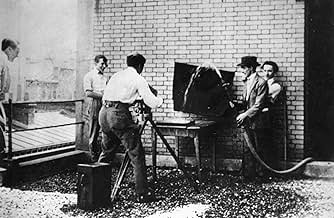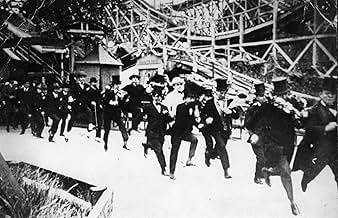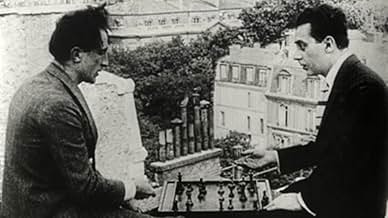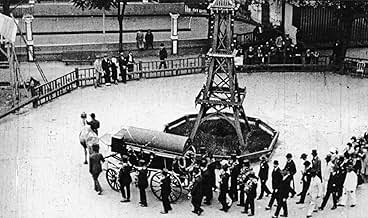Entr'acte
- 1924
- 22m
IMDb RATING
7.3/10
4.4K
YOUR RATING
An absolute dada movie. Somebody gets killed, his coffin gets out of control and after a chase it stops. The person gets out of it and let everybody who followed the coffin dissapear.An absolute dada movie. Somebody gets killed, his coffin gets out of control and after a chase it stops. The person gets out of it and let everybody who followed the coffin dissapear.An absolute dada movie. Somebody gets killed, his coffin gets out of control and after a chase it stops. The person gets out of it and let everybody who followed the coffin dissapear.
Inge Frïss
- La ballerine
- (as Mlle Frïss)
Man Ray
- Un joueur d'échecs
- (as Man-Ray)
Marcel Achard
- Un homme qui suit le corbillard
- (uncredited)
Georges Auric
- Un homme qui suit le corbillard
- (uncredited)
Georges Charensol
- Un homme qui suit le corbillard
- (uncredited)
Georges Lacombe
- Un homme qui suit le corbillard
- (uncredited)
Roger Le Bon
- Un homme qui suit le corbillard
- (uncredited)
Jean Mamy
- Un homme qui suit le corbillard
- (uncredited)
Rolf de Maré
- Un homme qui suit le corbillard
- (uncredited)
Erik Satie
- Un homme qui charge le canon
- (uncredited)
Pierre Scize
- Un homme qui suit le corbillard
- (uncredited)
Louis Touchages
- Un homme qui suit le corbillard
- (uncredited)
- Director
- Writers
- All cast & crew
- Production, box office & more at IMDbPro
Featured reviews
Entr'acte is a light-hearted example of Dada cinema of the 1920's. The tone is consistently playful and silly and you can just tell that the film-makers are having a laugh throughout. I'm certainly not too convinced that there is any particular message here. The emphasis of the film is using the cinematic medium to showcase inventive and surreal imagery in an amusing way. The narrative, such as it is, has us follow a funeral march. Although seeing as this is a Dada film, it's not exactly an ordinary march. For one thing it's led by a camel, and for another, the people in the procession bound around in slow motion for no discernible reason other than it looks funny.
The film itself was conceived as something to be shown in an intermission between other films. It clearly was never meant to be taken too seriously, and it's quite obvious that it was made in a way that allowed some of the leading proponents of the Dada/Surrealist movement to have fun and go for laughs. Surrealism was often an art-form with a sense of humour in any case, as anyone familiar with Salvador Dali's work could attest. Like most art films from the 20's Entr'acte has aged remarkably well and like others displays a sensibility that would be replicated many decades later in avant-garde cinema of the 60's and pop videos of the 80's and beyond. All-in-all a fun film to see.
The film itself was conceived as something to be shown in an intermission between other films. It clearly was never meant to be taken too seriously, and it's quite obvious that it was made in a way that allowed some of the leading proponents of the Dada/Surrealist movement to have fun and go for laughs. Surrealism was often an art-form with a sense of humour in any case, as anyone familiar with Salvador Dali's work could attest. Like most art films from the 20's Entr'acte has aged remarkably well and like others displays a sensibility that would be replicated many decades later in avant-garde cinema of the 60's and pop videos of the 80's and beyond. All-in-all a fun film to see.
This short film was conceived (hence the title) by René Clair as a diversion for the interval of the absurdist-Dadaist ballet "Relâche", with screenplay by Francis Picabia and music by Erik Satie, both artists at the forefront of the contemporary Parisian avant-garde. At the supposed first night performance in 1924, expectant patrons were greeted by locked doors and a notice bearing the single word "Relâche", which is the French word for "No Show". How absurd! Oh what fun!
To accompany the film, Satie composed a striking piece of orchestral music (arguably more significant than that for the ballet itself), and as expected the remastered film now has this added as its soundtrack, and a pretty good job has been made of editing the music to the action on the screen. This latter consists of a medley of surrealist sequences, culminating in a funeral procession, led by a camel, which escalates into a manic chase, intercut with footage from a big dipper. At the end, all the mourners disappear into thin air one by one; the corpse lives on. How significant all this is, as a narrative itself, as well as in the history of cinema as a whole, I am not qualified to comment, but it must have been seen as groundbreaking at the time, as well as good absurdist fun.
At the start of the film is a short sequence of two men firing a cannon from the roof of the Théâtre des Champs-Elysées and jumping up and down, which was shown separately at the opening of the ballet, not as part of Entr'acte. The two men are Picabia and Satie themselves. This footage is especially poignant, as Satie himself was dead within a year.
For Region 2 viewers, Entr'acte is included as a bonus with Clair's much later masterpiece "Les Grandes Manoeuvres".
To accompany the film, Satie composed a striking piece of orchestral music (arguably more significant than that for the ballet itself), and as expected the remastered film now has this added as its soundtrack, and a pretty good job has been made of editing the music to the action on the screen. This latter consists of a medley of surrealist sequences, culminating in a funeral procession, led by a camel, which escalates into a manic chase, intercut with footage from a big dipper. At the end, all the mourners disappear into thin air one by one; the corpse lives on. How significant all this is, as a narrative itself, as well as in the history of cinema as a whole, I am not qualified to comment, but it must have been seen as groundbreaking at the time, as well as good absurdist fun.
At the start of the film is a short sequence of two men firing a cannon from the roof of the Théâtre des Champs-Elysées and jumping up and down, which was shown separately at the opening of the ballet, not as part of Entr'acte. The two men are Picabia and Satie themselves. This footage is especially poignant, as Satie himself was dead within a year.
For Region 2 viewers, Entr'acte is included as a bonus with Clair's much later masterpiece "Les Grandes Manoeuvres".
René Clair's "Entr'acte" is one of the pioneering films of the surrealist genre in cinema, which, from what I gather, is the attempt at bending reality and twisting all that we've come to know into something deeply strange but entirely mesmerizing. Heavy on its use of perverse or unique imagery and juxtaposition of images and sequences and frequently rejecting the conventions of linear, dramatic filmmaking, such surrealist filmmakers today, such as Quentin Dupieux and Terry Gilliam, focus on a wide-range or visual styles in addition to wacky, out-there humor that is sometimes funny because it doesn't make a bit of sense (otherwise known as "anti-humor").
When it comes to "Entr'acte," however, we have an intriguing piece of film on our hands, one that serves as an early film of the "dadaism" movement in art, where European artists, writers, poets, filmmakers, and theorists began to reject commonly- utilized devices in art of the time in favor of a more radical approach to their mediums. These often included the injection of leftist policies and believes, most specifically anti-war policies that began hitting their stride as World War II neared.
Just by watching the first few minutes of "Entr'acte," one can see that it has no desire at all to try and fit in with conventional artistic standards. It serves as a conglomerate of visuals from the dadaist period, many of which not making very much sense, but each provoking a genre-bending fascination amongst the audience. The opening scene itself is something to marvel at, showing two people firing a cannon from the top of a large building, while strangely-calming and infectious music is played in the background.
The film persists on, with numerous different visuals that were likely never before seen outside of this particular work. What's remarkable is that despite the film's age, scenes involving characters running in slow motion and then being sped up into running in fast-motion after a vehicle still hold a certain kind of power to them. Overall, there's a mesmerizing quality "Entr'acte" bears that is surprising to note seeing as it perfectly defines a film that was "the first of its kind."
Directed by: René Clair.
When it comes to "Entr'acte," however, we have an intriguing piece of film on our hands, one that serves as an early film of the "dadaism" movement in art, where European artists, writers, poets, filmmakers, and theorists began to reject commonly- utilized devices in art of the time in favor of a more radical approach to their mediums. These often included the injection of leftist policies and believes, most specifically anti-war policies that began hitting their stride as World War II neared.
Just by watching the first few minutes of "Entr'acte," one can see that it has no desire at all to try and fit in with conventional artistic standards. It serves as a conglomerate of visuals from the dadaist period, many of which not making very much sense, but each provoking a genre-bending fascination amongst the audience. The opening scene itself is something to marvel at, showing two people firing a cannon from the top of a large building, while strangely-calming and infectious music is played in the background.
The film persists on, with numerous different visuals that were likely never before seen outside of this particular work. What's remarkable is that despite the film's age, scenes involving characters running in slow motion and then being sped up into running in fast-motion after a vehicle still hold a certain kind of power to them. Overall, there's a mesmerizing quality "Entr'acte" bears that is surprising to note seeing as it perfectly defines a film that was "the first of its kind."
Directed by: René Clair.
I watched Entr'acte (1924) during my first encounter with underground films, specifically in its avant-garde subgenre from the 1920s. This film, along with Buñuel-Dali's Un Chien Andalou (1927), immediately captivated me. Concurrently, I was studying Maya Dere's films, which inspired me to start creating my own underground/amateur/experimental short films between 2012 and 2015.
In Sheldon Renan's book on Underground Film, Entr'acte is considered one of the most impressive avant-garde films ever made. Renan labels it a "predecessor" of the underground film movement, which was then categorized as avant-garde. Entr'acte truly deserves this recognition because, considering the etymology of the term, it was undoubtedly a film ahead of its time. It stood apart from the mainstream Hollywood productions that dominated the era. René Clair, Man Ray, and Marcel Duchamp were acutely aware of the offerings to the strict bourgeois elite in Paris during a ballet concert. In the interlude between acts, they courageously introduced surrealist and dadaist ideas in film, challenging the norms of the time. This act demonstrated that Europe, particularly France, could also pioneer something revolutionary in this art form, breaking away from the conventions of Hollywood and mainstream cinema.
I would like to point out a particular scene in Entr'acte that could be interpreted as a metaphor for this subtle opposition to mainstream Hollywood and commercial films. In this scene, a man in Entr'acte fires a bullet from a shotgun directly at a balloon, which releases a dove. This imagery serves as a metaphor for liberation from the rigidity of standards not only within hegemonic Hollywood but also in cinema at large. It symbolizes the beginning of a new era, marked by the freedom to experiment with various forms and aesthetics. This period reached its peak in the 1960s, embracing a wide range of films that, while diverse in aesthetics, shared the spirit of freedom to explore cinematic possibilities. These filmmakers and artists, along with their successors, played a crucial role in advancing film techniques, many of which were developed specifically for their unconventional creations.
In Sheldon Renan's book on Underground Film, Entr'acte is considered one of the most impressive avant-garde films ever made. Renan labels it a "predecessor" of the underground film movement, which was then categorized as avant-garde. Entr'acte truly deserves this recognition because, considering the etymology of the term, it was undoubtedly a film ahead of its time. It stood apart from the mainstream Hollywood productions that dominated the era. René Clair, Man Ray, and Marcel Duchamp were acutely aware of the offerings to the strict bourgeois elite in Paris during a ballet concert. In the interlude between acts, they courageously introduced surrealist and dadaist ideas in film, challenging the norms of the time. This act demonstrated that Europe, particularly France, could also pioneer something revolutionary in this art form, breaking away from the conventions of Hollywood and mainstream cinema.
I would like to point out a particular scene in Entr'acte that could be interpreted as a metaphor for this subtle opposition to mainstream Hollywood and commercial films. In this scene, a man in Entr'acte fires a bullet from a shotgun directly at a balloon, which releases a dove. This imagery serves as a metaphor for liberation from the rigidity of standards not only within hegemonic Hollywood but also in cinema at large. It symbolizes the beginning of a new era, marked by the freedom to experiment with various forms and aesthetics. This period reached its peak in the 1960s, embracing a wide range of films that, while diverse in aesthetics, shared the spirit of freedom to explore cinematic possibilities. These filmmakers and artists, along with their successors, played a crucial role in advancing film techniques, many of which were developed specifically for their unconventional creations.
Originally played as an intermission with no sound, this film is now a must for any fan/historian of fine art. Featuring cameos by Man Ray, Marcel Duchamp, and other notables, Clair and Picabia's dada collage of different narratives, experimental use of the camera, and surrealist and absurdist images is the best example of experimental or dadaist films from the period. As unusual as it is to watch a film with no sound, the images created by the artists provide an extremely unique experience for the viewer. Fun for anyone, and especially interesting for those acquainted with the artists or the art movements themselves.
Did you know
- TriviaThe ballet "Relâche" ("Theatre Closed") premiered at the Théâtre des Champs Elyseés in Paris on December 4, 1924. Based on a book and with settings by Francis Picabia, it was a ballet in two acts commissioned and staged by the Ballets Suédois of Rolf de Maré, with choreography by Jean Börlin. As the title "Entr'acte" implies, this film was shown between the two acts, with music by Erik Satie.
- GoofsObvious stand-in for the close-up of Rolf de Maré getting kicked in head, which sends him (via reverse motion) flying back into the end title. The "kick" itself is clearly achieved through reverse motion.
- Alternate versionsThere is an Italian edition of this film on DVD, distributed by DNA Srl (2 Films on a single DVD). The film has been re-edited with the contribution of film historian Riccardo Cusin. This version is also available for streaming on some platforms.
- ConnectionsEdited into Avant-garde Cinema (1960)
Details
- Runtime
- 22m
- Color
- Sound mix
- Aspect ratio
- 1.33 : 1
Contribute to this page
Suggest an edit or add missing content






















